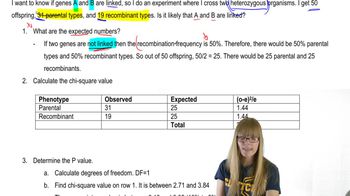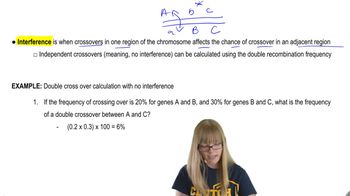Table of contents
- 1. Introduction to Genetics51m
- 2. Mendel's Laws of Inheritance3h 37m
- 3. Extensions to Mendelian Inheritance2h 41m
- 4. Genetic Mapping and Linkage2h 28m
- 5. Genetics of Bacteria and Viruses1h 21m
- 6. Chromosomal Variation1h 48m
- 7. DNA and Chromosome Structure56m
- 8. DNA Replication1h 10m
- 9. Mitosis and Meiosis1h 34m
- 10. Transcription1h 0m
- 11. Translation58m
- 12. Gene Regulation in Prokaryotes1h 19m
- 13. Gene Regulation in Eukaryotes44m
- 14. Genetic Control of Development44m
- 15. Genomes and Genomics1h 50m
- 16. Transposable Elements47m
- 17. Mutation, Repair, and Recombination1h 6m
- 18. Molecular Genetic Tools19m
- 19. Cancer Genetics29m
- 20. Quantitative Genetics1h 26m
- 21. Population Genetics50m
- 22. Evolutionary Genetics29m
4. Genetic Mapping and Linkage
Crossing Over and Recombinants
Problem 21b
Textbook Question
Gene R and gene T are genetically linked. Answer the following questions concerning a dihybrid organism with the genotype Rt/rT:
If two crossover events occur between these two genes, what are the genotypes of the recombinant chromosomes?
 Verified step by step guidance
Verified step by step guidance1
Understand that genetic linkage means that genes R and T are located close to each other on the same chromosome, and their inheritance is not completely independent.
Recognize that the genotype Rt/rT indicates that the organism is heterozygous for both genes, with one chromosome carrying the alleles R and t, and the other chromosome carrying the alleles r and T.
Recall that a double crossover event involves two separate crossover events occurring between the two linked genes, effectively swapping the alleles between the homologous chromosomes twice.
Determine the recombinant chromosomes by analyzing the effect of the double crossover. The first crossover will exchange alleles between the homologous chromosomes, and the second crossover will reverse the exchange, resulting in recombinant chromosomes with the genotypes RT and rt.
Conclude that the recombinant chromosomes resulting from two crossover events are RT and rt, as these are the new combinations of alleles formed after the double crossover process.
 Verified video answer for a similar problem:
Verified video answer for a similar problem:This video solution was recommended by our tutors as helpful for the problem above
Video duration:
7mPlay a video:
Was this helpful?
Key Concepts
Here are the essential concepts you must grasp in order to answer the question correctly.
Genetic Linkage
Genetic linkage refers to the tendency of genes located close to each other on the same chromosome to be inherited together during meiosis. This occurs because linked genes are less likely to be separated by recombination events, which can shuffle alleles between homologous chromosomes. Understanding linkage is crucial for predicting the inheritance patterns of traits controlled by these genes.
Recommended video:
Guided course

Chi Square and Linkage
Crossover Events
Crossover events occur during meiosis when homologous chromosomes exchange segments of genetic material. This process results in new combinations of alleles, leading to genetic diversity in gametes. In the context of linked genes, the number and location of crossover events can significantly affect the genotypes of the resulting recombinant chromosomes.
Recommended video:
Guided course

Multiple Cross Overs and Interference
Recombinant Genotypes
Recombinant genotypes are the genetic combinations that arise from crossover events between linked genes. When two crossover events occur, they can produce chromosomes that carry different combinations of alleles than the parental types. Identifying these recombinant genotypes is essential for understanding the genetic variation and inheritance patterns in offspring.
Recommended video:
Guided course

Gamete Genotypes
Related Videos
Related Practice
Textbook Question
Two different female Drosophila were isolated, each heterozygous for the autosomally linked genes b (black body), d (dachs tarsus), and c (curved wings). These genes are in the order d–b–c, with b being closer to d than to c. Shown here is the genotypic arrangement for each female along with the various gametes formed by both:Identify which categories are noncrossovers (NCOs), single crossovers (SCOs), and double crossovers (DCOs) in each case. Then, indicate the relative frequency in which each will be produced.
751
views


